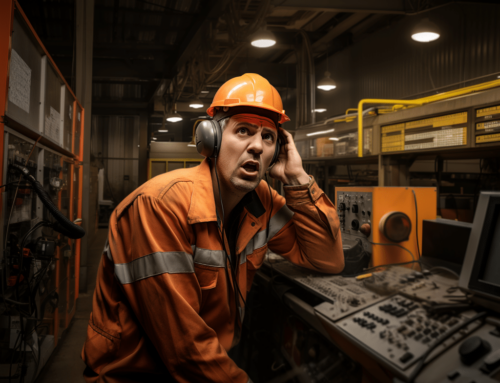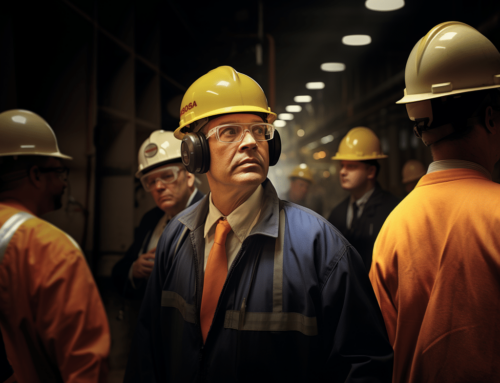Comprehending the Role of Personal Protective Equipment in Occupational Health
Grasping the importance of Personal Protective Equipment (PPE) is paramount in today’s demanding work environments.
It’s not just a safety measure—it’s a protective shield that guards worker safety in various job tasks and different work conditions.
Initially, let’s comprehend the basics of PPE, like safety helmets, safety goggles, harnesses and more, before traversing through its application across vivid industries.
Lastly, we will shed light on the enforced PPE safety standards and effective strategies for workplace safety.
Stay tuned to unlock the door to a safer workspace!
Understanding the Definition of Personal Protective Equipment (PPE)
One pivotal component related to workplace safety is Personal Protective Equipment, often abbreviated to PPE. It encompasses a wide range of devices designed to shield workers from specific job tasks hazards. From safety helmets providing head protection to earplugs offering ear protection, this equipment plays a critical role in worker safety.
Given work conditions differing from one worksite to the next, the type of PPE needed may vary significantly. Performing a thorough hazard assessment, taking into account all potential workplace hazards plays a key role in selecting the appropriate PPE. Criteria covered by the American National Standards Institute helps to standardize PPE selection industry-wide.
For an instance, employees working around molten metal may require body protection such as safety footwear, safety goggles or a welding shield. On the other hand, those who are exposed to airborne contaminants may need gas masks, breathing equipment or a respirator to protect their health. Each piece of PPE is designed to mitigate specific types of employee exposure, thus enhancing health protection on the job.
Of course, ensuring every worker uses their PPE correctly is as important as its selection. It calls for an approach where we train employees correctly in handling equipment for optimum performance. The National Institute for Occupational Safety and Health, Occupational Safety and Health Administration and other regulating bodies offer valuable guidance on effective PPE use and standards.
Exploring the Importance of PPE in Occupational Health
The use of PPE extends beyond just compliance with safety guidelines; it is a pro-active step toward protecting human resources. When complemented with effective work practices, PPE can limit employee exposure to potential hazards in the workspace and foster a culture of safety. This culture of prevention is not limited to English speakers; PPE importance extends equally to those who speak other languages such as español, reinforcing its universal relevance.
Eye protection is also paramount to occupational health. Thus, workers with roles putting them at risk of eye injury should always don safety glasses or safety goggles. Face shields provide a more comprehensive solution, covering the entire face, while side shields offer additional protection to the sides of the eyes.
Hearing protection, like ear plugs, is vital, especially in industries characterized by high noise levels. Prolonged exposure to noise, without the aid of ear protection, can lead to irreversible hearing damage. Other PPE like respirators work in tandem with engineering controls to manage respiratory risks, such as dust or chemical exposure.
In demanding industries, the use of safety helmets and bump caps protect against head injuries. Other body protection mechanisms, such as harnesses, safety shoes, or face masks, can further aid in creating a safer working environment. Ultimately, occupational safety is a multi-faceted endeavor in which the role of risk assessment is as crucial as the right PPE.
Different Types of PPE and Their Application in Various Industries
The manufacturing industry, for instance, often deals with processes involving molten metal. Here, body protection is crucial where using pieces such as a welding shield, safety goggles, safety footwear, or face masks are common. The use of these items helps protect against potential burns and eye injuries.
On construction sites, head protection takes precedence due to the risk of falling objects. It’s not uncommon to spot workers donning safety helmets and bump caps as a standard measure against potential injuries. Moreover, harnesses are also used widely to prevent falls from heights.
In industries exposing workers to harmful airborne particles and gases, the role of respirators and other forms of breathing equipment shouldn’t be overlooked. Gas masks and respirators serve as vital pieces of equipment that filter out dangerous contaminants and cleanse the air breathed in, reducing the health risks associated with certain work conditions.
The healthcare industry places a high emphasis on personal hygiene and patient safety. In this setting, healthcare workers often use disposable gloves and face masks to prevent disease transmission. Eye protection like safety goggles is also critical, especially in medical laboratories where chemical exposure is likely.
Examining PPE Safety Standards and Regulations
The National Institute for Occupational Safety and Health (NIOSH) and the Occupational Safety and Health Administration (OSHA) are amongst the key regulatory bodies governing PPE usage in the United States. They have established various rules and regulations to help control workplace hazards and to ensure worker safety. Such guidance covers the entire PPE lifecycle, from selection to utilization and maintenance.
The American National Standards Institute (ANSI) is another major player that sets the safety standards for different types of PPE. Compliance with ANSI’s safety standards certifies that specific PPE, be it safety shoes, safety helmets or safety glasses, meets the requirements set, offering workers the best protection possible against workplace hazards.
Through careful risk assessment, companies can identify the types of protective equipment that their employees need. This includes discerning between different types of respirators (RPE), eye protection, or ear protection required. Following the safety regulations can help ensure that every worker is given the necessary protection for their specific job tasks.
Auditing is a crucial process that ensures ongoing compliance with these standards. Regular audits help to detect any potential gaps in the enforcement of workplace safety regulations. Additionally, it encourages companies to continuously elevate their safety practices, ultimately fostering a safer workspace for their employees.
Effective Strategies to Ensure Correct Use of PPE in the Workplace
A robust training program is essential to ensure employees know how to use PPE properly. Employees need to understand not only where and when to use these protective devices but how to wear them correctly. Regular training sessions, along with live demonstrations, can be effective teaching strategies to enhance workplace safety.
Organizational commitment to a culture of safety is also key. When employees see their leaders endorsing safety norms, including PPE usage and other safety measures, they are more likely to model the same behavior. This top-down approach can significantly influence overall safety compliance within the workforce.
Periodic inspections of PPE and job site evaluations also help ensure proper use and compliance. Checking for worn-out gear, incorrectly fitted equipment, or deficient safety measures can prevent accidents and enhance worker safety. Additionally, site-specific hazard assessments can also guide the necessary updates in PPE or its usage.
Finally, continuous communication regarding the importance of PPE is essential. Regular safety meetings, updated safety protocols, visual reminders around the worksite, or use of mobile safety apps are a few ways to keep safety, including proper PPE usage, in the forefront of each employee’s mind. These initiatives can help cultivate a safety-first mindset, thereby reducing employee exposure and increasing their health protection.
Monitoring and Maintaining PPE Condition Through Regular Inspections
To ensure the effectiveness of Personal Protective Equipment (PPE), companies must incorporate regular inspections in their safety protocols. The condition of PPE is influenced by factors like the environment, extent of usage and the quality of the equipment itself. Sustained exposure to harsh conditions, regular wear and tear, or machine malfunctions could reduce the functionality of PPE, thus demanding consistent checks.
Upon identifying damaged or worn-out PPE during inspections, companies should immediately replace them with new ones. Continuing usage of such compromised gear could expose workers to hazardous conditions, leading to potentially preventable injuries. Helmets with cracks, respirators with damaged filters, or safety goggles with scratched lenses are examples of PPE conditions that require urgent attention.
In addition to inspecting PPE, its correct storage and maintenance also plays a key role. For example, safety glasses and face shields should be kept in a clean, dry place to avoid lens damage, while gas masks and respirators require proper sealing and storage to maintain their filtration efficacy. Following manufacturers’ maintenance guidelines is thus critical in prolonging the lifespan of PPE.
Routine inspections of PPE are a proactive measure towards safeguarding workers, an essential component of risk management. By implementing a robust inspection system, employers can ensure that their workforce remains protected, and PPE continues its role in guaranteeing worker safety, aligning with the guidelines provided by safety regulators such as the Occupational Safety and Health Administration (OSHA).
Conclusion
Personal Protective Equipment (PPE), a vital component of workplace safety strategies, plays a significant role in shielding workers from occupational hazards.
Its application varies, depending on job tasks, risk assessment and work conditions, thus spanning areas like safety helmets for head protection, earplugs for hearing safety, safety goggles for eye protection, and respirators for breathing safety.
Ensuring proper selection of PPE, compliance with safety standards set by authorities such as NIOSH, OSHA, and ANSI, and the efficient training of employees are collective endeavours towards creating a safer workspace.
Regular inspections, maintenance, and replacements, in line with workplace safety guidelines, further enhance the condition and utility of PPE.
It reiterates that comprehending the role of PPE is crucial to occupational health and safety.







